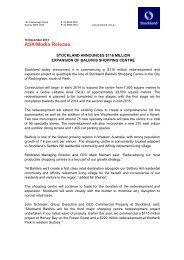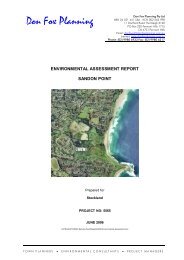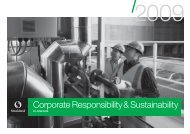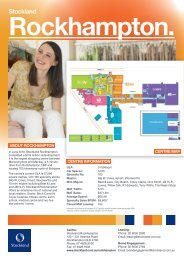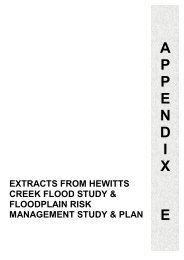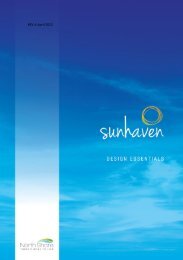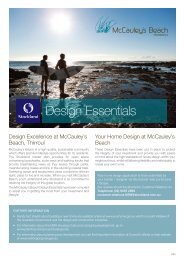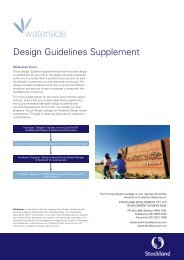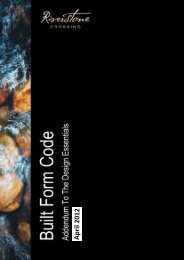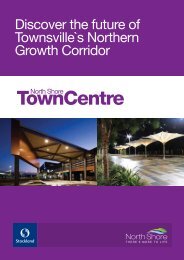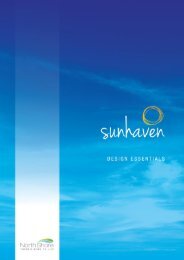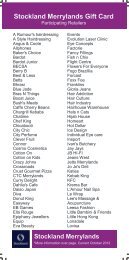Stockland Direct Retail Trust No.1
Stockland Direct Retail Trust No.1
Stockland Direct Retail Trust No.1
Create successful ePaper yourself
Turn your PDF publications into a flip-book with our unique Google optimized e-Paper software.
<strong>Stockland</strong> <strong>Direct</strong> <strong>Retail</strong> <strong>Trust</strong> No. 1 and its controlled entities<br />
Notes to the Consolidated Financial Statements<br />
For the Year Ended 30 June 2009<br />
1 Summary of significant<br />
accounting policies<br />
<strong>Stockland</strong> <strong>Direct</strong> <strong>Retail</strong> <strong>Trust</strong> No. 1 (“the <strong>Trust</strong>”)<br />
is a Managed Investment Scheme domiciled in<br />
Australia. The consolidated Financial Report<br />
as at and for the financial year ended 30 June<br />
2009 comprises of the Financial Report of the<br />
<strong>Trust</strong> and its controlled entities (“the<br />
consolidated entity”).<br />
The Financial Report as at and for the financial<br />
year ended 30 June 2009 was authorised for<br />
issue by the <strong>Direct</strong>ors of the Responsible<br />
Entity on 20 August 2009.<br />
(a) Statement of compliance<br />
The Financial Report is a general purpose<br />
financial report which has been prepared in<br />
accordance with Australian Accounting<br />
Standards (“AASBs”) (including Australian<br />
Interpretations) adopted by the Australian<br />
Accounting Standards Board (“AASB”) and the<br />
Corporations Act 2001. The Financial Report<br />
of the consolidated entity and the <strong>Trust</strong> comply<br />
with the International Financial Reporting<br />
Standards (“IFRSs”) and interpretations<br />
adopted by the International Accounting<br />
Standards Board (“IASB”).<br />
(b) Basis of preparation<br />
The Financial Report has been prepared on<br />
the basis of the going concern and historical<br />
cost conventions except for derivative financial<br />
instruments and investment properties which<br />
are stated at their fair value.<br />
As at 30 June 2009, the consolidated entity<br />
has a net current asset deficiency of<br />
$55,028,000, which is mainly due to the<br />
current classification of the <strong>Trust</strong>’s loan facility,<br />
due to expire on 22 December 2009. The<br />
ability of the consolidated entity to continue as<br />
a going concern and meet its debts and<br />
commitments as they fall due is dependent<br />
upon the <strong>Trust</strong> being successful in refinancing<br />
the loan facility and the <strong>Trust</strong> being in<br />
compliance with future loan covenants which<br />
may require the sale of one or more of the<br />
consolidated entity’s properties to reduce the<br />
outstanding loan facility.<br />
The <strong>Direct</strong>ors are not aware of any<br />
circumstances that may lead to the <strong>Trust</strong> not<br />
obtaining refinancing of the loan facility prior to<br />
the expiry to the existing loan facility. On the<br />
date of this report, being 20 August 2009,<br />
based on information known at that date, the<br />
<strong>Direct</strong>ors have formed the view that the<br />
Financial Report for the year ended 30 June<br />
2009, can be prepared on a going concern<br />
basis as they believe reasonable grounds exist<br />
to expect the loan facility will be refinanced.<br />
The <strong>Direct</strong>ors believe that while this is a<br />
material uncertainty, it does not cast doubt on<br />
the consolidated entity’s ability to continue as<br />
a going concern.<br />
This view was formed by taking into account<br />
a number of factors including the financial<br />
position of the consolidated entity as at<br />
30 June 2009 and information known at the<br />
date of this report, and includes the following:<br />
• As at 30 June 2009, the consolidated<br />
entity’s total assets equal $81,102,000.<br />
This value is 1.4 times the amount of drawn<br />
debt of $56,149,000; and<br />
• The <strong>Trust</strong> can demonstrate that it can<br />
service the interest payments on the<br />
existing loan facility. In addition, the <strong>Trust</strong><br />
will be able to fund an increase in margin<br />
on the loan facility.<br />
Further information in relation to the loan<br />
facility can be found in Note 14 to the Financial<br />
Report.<br />
The <strong>Trust</strong> is an entity of the kind referred to in<br />
ASIC Class Order 98/100 (as amended) and in<br />
accordance with that Class Order, amounts in<br />
the Financial Report have been rounded to the<br />
nearest thousand dollars, unless otherwise<br />
stated.<br />
The preparation of Financial Statements<br />
requires management to make judgements,<br />
estimates and assumptions that affect the<br />
application of accounting policies and<br />
reported amounts of assets, liabilities, income<br />
and expenses. Actual results may differ from<br />
these estimates. Estimates and underlying<br />
assumptions are reviewed on an ongoing<br />
basis. Revisions to accounting estimates are<br />
recognised in the period in which the estimate<br />
is revised and in any future periods affected.<br />
Refer to Note 2 for significant areas of<br />
estimation.<br />
The accounting policies have been applied<br />
consistently throughout the consolidated entity<br />
for the purposes of this Financial Report.<br />
The significant policies which have been<br />
adopted in the preparation of this Financial<br />
Report are:<br />
(c) Revenue recognition<br />
Revenue is recognised at the fair value of the<br />
consideration received or receivable net of the<br />
amount of goods and services tax (“GST”)<br />
levied.<br />
Revenue is recognised for the major business<br />
activities as follows:<br />
Rent from investment properties<br />
Rent from investment properties is recognised<br />
in the Income Statement on a straight-line<br />
basis over the lease term. Rent not received at<br />
balance date is reflected in the Balance Sheet<br />
as a receivable or if paid in advance, as rents<br />
in advance. Lease incentives granted are<br />
recognised over the lease term, on a straightline<br />
basis, as a reduction of rent.<br />
Interest income<br />
Interest income is recognised in the Income<br />
Statement as it accrues using the effective<br />
interest method and if not received at balance<br />
date, is reflected in the Balance Sheet as a<br />
receivable.<br />
Distributions<br />
Revenue from distributions from controlled<br />
entities are recognised in the Income<br />
Statement on the date the <strong>Trust</strong>’s right to<br />
receive payment is established, being the date<br />
when they are declared by those entities.<br />
(d) Segment reporting<br />
A segment is a distinguishable component of<br />
the consolidated entity that is engaged either<br />
in providing related products or services<br />
(business segment), or in providing products<br />
or services within a particular economic<br />
environment (geographical segment), which is<br />
subject to risks and rewards that are different<br />
from those of other segments.<br />
(e) Goods and services tax<br />
Revenues, expenses and assets are<br />
recognised net of the amount of GST except<br />
where the amount of GST incurred is not<br />
recoverable from the relevant taxation<br />
authority. In these circumstances, the GST is<br />
recognised as part of the cost of acquisition of<br />
the asset or as part of the expense.<br />
Receivables and payables are stated with the<br />
amount of GST included. The net amount of<br />
GST recoverable from, or payable to, the<br />
relevant taxation authority is included as a<br />
current asset or liability in the Balance Sheet.<br />
Cash flows are included in the Cash Flow<br />
Statement on a gross basis. The GST<br />
components of cash flows arising from<br />
investing and financing activities which are<br />
recoverable from, or payable to, the taxation<br />
authority are classified as operating cash<br />
flows.<br />
(f) Income tax<br />
Under current Australian income tax<br />
legislation, the <strong>Trust</strong> and the consolidated<br />
entity are not liable for income tax, provided<br />
that the taxable income (including any<br />
assessable component of any capital gains<br />
from the sale of investment assets) is fully<br />
distributed to Unitholders each year. Tax<br />
allowances for building, plant and equipment<br />
depreciation are distributed to Unitholders in<br />
the form of tax deferred components of<br />
distributions.<br />
<strong>Stockland</strong> <strong>Direct</strong> <strong>Retail</strong> <strong>Trust</strong> No. 1 June 2009 9



